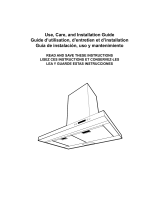
14
IMPORTANTES INSTRUCTIONS DE SÉCURITÉ
AVERTISSEMENT :
POUR RÉDUIRE LE RISQUE
D'INCENDIE, CHOC ÉLECTRIQUE OU DOMMAGES
CORPORELS, RESPECTER LES INSTRUCTIONS
SUIVANTES :
■ Utiliser cet appareil uniquement dans les applications
envisagées par le fabricant. Pour toute question, contacter le
fabricant.
■ Avant d'entreprendre un travail d'entretien ou de nettoyage,
interrompre l'alimentation de la hotte au niveau du tableau de
disjoncteurs, et verrouiller le tableau de disjoncteurs pour
empêcher tout rétablissement accidentel de l'alimentation du
circuit. Lorsqu'il n'est pas possible de verrouiller le tableau de
disjoncteurs, placer sur le tableau de disjoncteurs une
étiquette d'avertissement proéminente interdisant le
rétablissement de l'alimentation.
■ Tout travail d'installation ou câblage électrique doit être
réalisé par une personne qualifiée, dans le respect des
prescriptions de tous les codes et normes applicables, y
compris les codes du bâtiment et de protection contre les
incendies.
■ Ne pas faire fonctionner un ventilateur dont le cordon ou la
fiche est endommagé(e). Jeter le ventilateur ou le retourner à
un centre de service agréé pour examen et/ou réparation.
■ Une source d'air de débit suffisant est nécessaire pour le
fonctionnement correct de tout appareil à gaz (combustion et
évacuation des gaz à combustion par la cheminée), pour qu'il
n'y ait pas de reflux des gaz de combustion. Respecter les
directives du fabricant de l'équipement de chauffage et les
prescriptions des normes de sécurité - comme celles publiées
par la National Fire Protection Association (NFPA) et
l'American Society for Heating, Refrigeration and Air
Conditioning Engineers (ASHRAE), et les prescriptions des
autorités réglementaires locales.
■ Lors d'opérations de découpage et de perçage dans un
mur ou un plafond, veiller à ne pas endommager les câblages
électriques ou canalisations qui peuvent s'y trouver.
■ Les ventilateurs d'évacuation doivent toujours décharger
l'air à l'extérieur.
MISE EN GARDE :
Cet appareil est conçu uniquement pour
la ventilation générale. Ne pas l'utiliser pour l'extraction de
matières ou vapeurs dangereuses ou explosives.
MISE EN GARDE :
Pour minimiser le risque d'incendie et
évacuer adéquatement les gaz, veiller à acheminer l'air aspiré
par un conduit jusqu'à l'extérieur - ne pas décharger l'air
aspiré dans un espace vide du bâtiment comme une cavité
murale, un plafond, un grenier, un vide sanitaire ou un
garage.
AVERTISSEMENT :
POUR RÉDUIRE LE RISQUE
D'INCENDIE, UTILISER UNIQUEMENT DES CONDUITS
MÉTALLIQUES.
AVERTISSEMENT :
POUR MINIMISER LE RISQUE D'UN FEU
DE GRAISSE SUR LA CUISINIÈRE :
■ Ne jamais laisser un élément de surface fonctionner à
puissance de chauffage maximale sans surveillance. Un
renversement/débordement de matière graisseuse pourrait
provoquer une inflammation et la génération de fumée. Utiliser
une puissance de chauffage moyenne ou basse pour le
chauffage d'huile.
■ Veiller à toujours faire fonctionner le ventilateur de la hotte lors
de la cuisson avec une puissance de chauffage élevée ou lors
de la cuisson d'un mets à flamber (à savoir crêpes Suzette,
cerise jubilée, steak au poivre flambé).
■ Nettoyer fréquemment les ventilateurs d'extraction. Veiller à
ne pas laisser la graisse s'accumuler sur les surfaces du
ventilateur ou des filtres.
■ Utiliser toujours un ustensile de taille appropriée. Utiliser
toujours un ustensile adapté à la taille de l'élément chauffant.
AVERTISSEMENT :
POUR RÉDUIRE LE RISQUE DE
DOMMAGES CORPORELS APRÈS LE DÉCLENCHEMENT
D'UN FEU DE GRAISSE SUR LA CUISINIÈRE, APPLIQUER
LES RECOMMANDATIONS SUIVANTES :
(a)
■ Placer sur le récipient un couvercle bien ajusté, une tôle à
biscuits ou un plateau métallique POUR ÉTOUFFER LES
FLAMMES, puis éteindre le brûleur. VEILLER À ÉVITER LES
BRÛLURES. Si les flammes ne s'éteignent pas immédiatement,
ÉVACUER LA PIÈCE ET APPELER LES POMPIERS.
■ NE JAMAIS PRENDRE EN MAIN UN RÉCIPIENT
ENFLAMMÉ - vous risquez de vous brûler.
■ NE PAS UTILISER D'EAU, ni un torchon humide - ceci
pourrait provoquer une explosion de vapeur brûlante.
■ Utiliser un extincteur SEULEMENT si :
– Il s'agit d'un extincteur de classe ABC, dont on connaît le
fonctionnement.
– Il s'agit d'un petit feu encore limité à l'endroit où il s'est déclaré.
– Les pompiers ont été contactés.
– Il est possible de garder le dos orienté vers une sortie pendant
l'opération de lutte contre le feu.
(a)
Recommandations tirées des conseils de sécurité en cas
d'incendie de cuisine publiés par la NFPA.
■ AVERTISSEMENT : Pour réduire le risque d'incendie ou de
choc électrique, ne pas utiliser ce ventilateur avec un
quelconque dispositif de réglage de la vitesse à semi-
conducteurs.
LIRE ET CONSERVER CES INSTRUCTIONS























